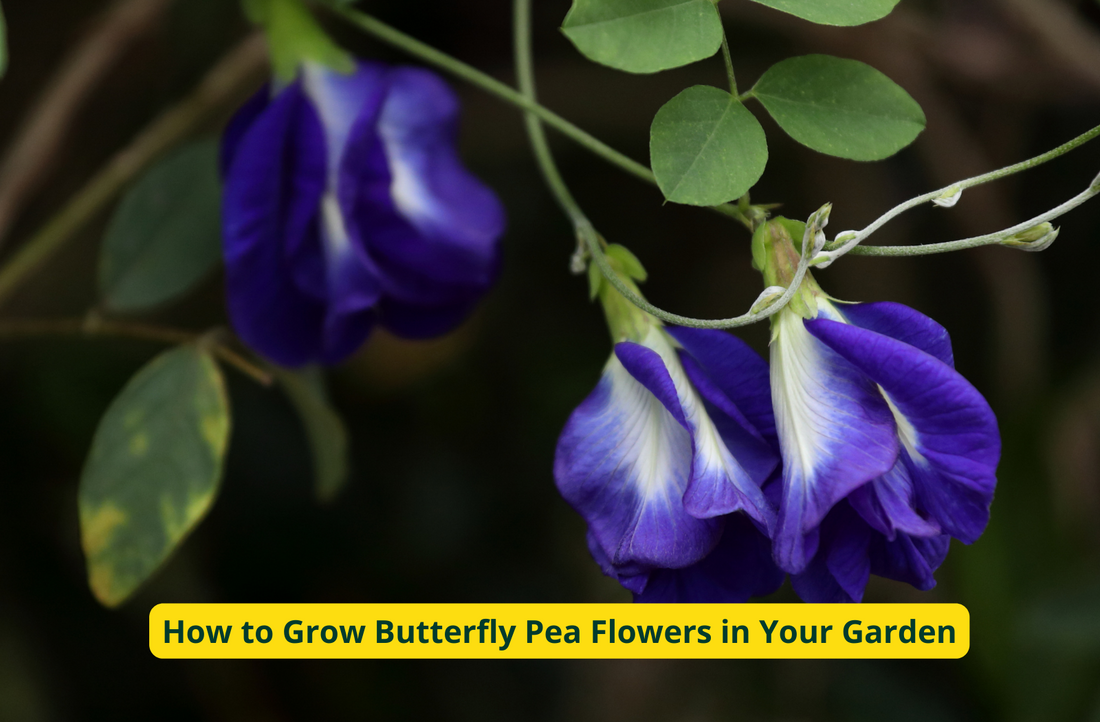Butterfly pea flowers (Clitoria ternatea), also known as blue pea or Asian pigeonwings, are not only a stunning addition to any garden but also come with a myriad of practical uses. From vibrant blue blossoms to natural dye, these flowers offer both aesthetic appeal and functionality. In this guide, we'll walk you through the step-by-step process of planting and caring for butterfly pea flowers, ensuring a flourishing garden filled with these enchanting blooms.
1. Selecting Butterfly Pea Seeds or Seedlings:
- Choose Quality Seeds: If starting from seeds, select high-quality butterfly pea seeds from a reputable source. Ensure they are fresh and viable for better germination.
- Opt for Seedlings: Alternatively, you can purchase established seedlings from a local nursery for a head start on the growing process.

2. Preparing the Soil:
- Well-Draining Soil: Butterfly pea flowers prefer well-draining soil. Amend heavy clay soil with organic matter or use a potting mix specifically designed for flowering plants.
- Optimal pH: Aim for a slightly acidic to neutral pH level, ideally between 6.0 and 7.0.
3. Planting Butterfly Pea Seeds or Seedlings:
- Sow Seeds Directly or Start Indoors: Plant seeds directly in the garden after the last frost or start them indoors a few weeks earlier. If using seedlings, transplant them after the risk of frost has passed.
- Spacing: Space the seeds or seedlings about 6 to 12 inches apart, allowing enough room for the mature plants to spread.
- Planting Depth: Sow seeds at a depth of about 1 inch in the soil. If transplanting seedlings, make sure they are planted at the same depth as they were in their containers.
4. Watering Requirements:
- Consistent Moisture: Keep the soil consistently moist, especially during the initial stages of growth. Water deeply to encourage the development of a robust root system.
- Avoid Waterlogged Soil: While butterfly pea flowers appreciate consistent moisture, they do not tolerate waterlogged soil. Ensure proper drainage to prevent root rot.
5. Sunlight Needs:
- Full Sun: Butterfly pea flowers thrive in full sunlight. Plant them in an area that receives at least 6 to 8 hours of direct sunlight per day for optimal blooming.
- Partial Shade in Hot Climates: In regions with intense heat, providing some afternoon shade can help protect the plants from stress and scorching.
6. Fertilization:
- Balanced Fertilizer: Use a balanced, all-purpose fertilizer during the growing season. Apply the fertilizer according to the manufacturer's recommendations, typically in spring and midsummer.
- Avoid Excessive Fertilization: While butterfly pea flowers benefit from nutrients, avoid excessive fertilization, as this can lead to lush foliage at the expense of blooming.
7. Support and Trellising:
- Provide Support: Butterfly pea plants can be somewhat sprawling. Consider providing support or installing a trellis to encourage an upright growth habit and showcase the flowers more prominently.
8. Pruning and Deadheading:
- Regular Deadheading: Remove faded or spent blossoms regularly to encourage continuous blooming.
- Pruning: Prune the plants lightly to control their size and shape. This can be done throughout the growing season.
9. Pest and Disease Management:
- Watch for Pests: Keep an eye out for common garden pests like aphids or spider mites. Hose off pests or use insecticidal soap as needed.
- Prevent Overcrowding: Proper spacing and air circulation can help prevent fungal diseases. Thin out overcrowded areas if necessary.
- ot spells, and consider providing partial shade to shield them from extreme heat.
10. Harvesting Butterfly Pea Flowers:
- Timing: Harvest butterfly pea flowers when they are fully open, typically in the morning.
- Edible Uses: The flowers are edible and are often used to make vibrant blue tea or add a natural blue hue to various culinary creations.
- Drying: To preserve the flowers, you can air-dry them for later use in teas or crafts.
11. Propagation:
- Collecting Seeds: If you want to propagate more butterfly pea plants, collect seeds from mature pods and store them for the next growing season.
By following these step-by-step instructions and considering specific climate considerations, you can cultivate a garden adorned with the captivating beauty of butterfly pea flowers. Whether you're drawn to their ornamental appeal or their versatile uses, these charming blossoms are sure to add a touch of enchantment to your outdoor space.
Gardener services
Landscaping services
Online nursery
Organic pesticides and fertilizers
Extra reading
9 Most Powerful Medicinal Plants You Can Grow At Home in Bangalore
10 Medicinal Plants to Grow at Home
What are the benefits of Turmeric ?
Doddapatre Indian Borage - Health Benefits
Happy Gardening!
Dr. Vandana K.

